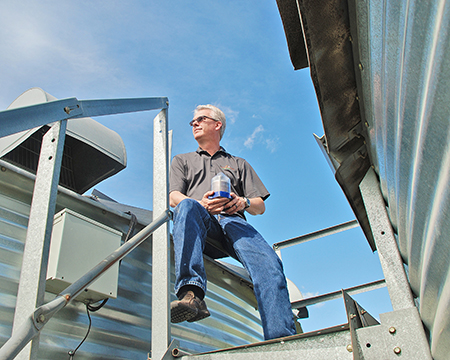This yearlong endeavor looks at how four farmers are evaluating technology and agronomic information that can boost the productivity of their operations.

There is no escaping physical labor on the farm, but for Steve Cubbage, the real heavy lifting takes place in his head. Specifically, the Nevada, Mo., farmer's thought process focuses on inefficiencies that act as a profitability drag in corn and soybean production.
"We live and breathe precision agriculture, but we also realize there are still plenty of inefficiencies to overcome," he says.
"When you're staring at $3.50 corn rather than $7 corn, you have an added incentive to learn a better way."
Facing tight margins, Cubbage is focused on saving cropdollars. More precisely, he aims to preserve them.
"Like a lot of farmers, we've increased on-farm storage inorder to play that basis game and to facilitate harvest," Cubbagesays. "But, like a lot of farmers, we tend to overdry the crop just to make extra sure it doesn't go out of condition."
"The issue there is that, if you overdry even by one percentage point, you're drying up dollars. You could be losing 2 or 3% of your profits after the work and investment you've made in producing that crop."
Cubbage has found a solution in precision technology. This summer, he's installing sensors in his new 65,000-bushel bin after testing them in a 25,000-bushel bin last fall.
The sensors are embedded in cables suspended from the bin ceiling and anchored 18 inches above the floor with fishing line, which will be snapped by the sweep auger when the bin is emptied. The cables remain and need only to be reanchored before the bin is refilled. ACCESS 24/7. Wires from the cables gather at the peak in a Wi-Fi node that acts like an Internet connection router does in a home or office computer system. With apps on his iPhone or iPad, he can monitor grain condition remotely throughout the entire bin.
"You can certainly old-school check your grain manually, but this app shows you in 3-D exactly where you have an issue," Cubbage explains.
A 25,000-bushel bin utilizes four to five cables, which are produced by AgSense. Two monitor temperature and moisture, and the others measure temperature only. Cubbage figures the system is most cost-effective for 25,000-bushel and larger grain bins, and will range in price, between 15 and 20 cents per bushel.
"There's a bitter irony to losing what amounts to a significant quantity of grain by overdrying," he says. "You had it and then lost it. And, you not only lost it, you actually paid money to lose it with what you spent on the propane bill and the electric bill, and so forth."
BASF Innovation Specialist Kaleb Hellwig appreciates Cubbage's use of sensor technology to protect and maximize crop value, because it's his job to provide agronomic expertise to facilitate a successful harvest. In the current cropproduction environment, Hellwig is urging growers he works with to take a critical look at all management choices and inputs. "Not all [of them] will provide a positive return on investment this year," he says.
For Cubbage, it's all part of an integrated system. "We're trying to think in broader terms regarding technology adaptation and utilization," he notes. "The problem I see is that, in a lot of tech circles, precision ag is dominated by the iron companies. We must see precision ag as a whole lot more than auto-steer."